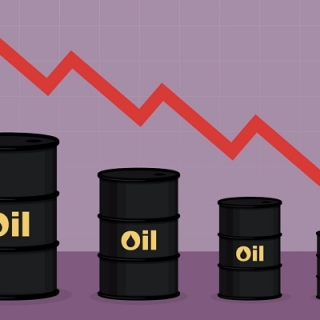


Oil prices fell on Monday as investors weighed the prospects for ceasefire talks aimed at ending the Russia-Ukraine war, which could lead to increased Russian oil supplies to global markets.
Brent crude futures fell 25 cents, or 0.4%, to $71.91 a barrel by 0409 GMT. U.S. West Texas Intermediate crude futures fell 20 cents, or 0.3%, to $68.08.
Both benchmarks closed higher on Friday and posted their second straight weekly gain as new U.S. sanctions on Iran and the latest output plan from the OPEC+ producer group raised expectations of tighter supplies.
A U.S. delegation will seek progress toward a Black Sea ceasefire and a broader cessation of violence in the war in Ukraine when it meets for talks with Russian officials on Monday, following discussions with Ukrainian diplomats on Sunday. "Hopes for progress in peace talks between Russia and Ukraine and the potential easing of U.S. sanctions on Russian oil are pushing prices lower," said Toshitaka Tazawa, an analyst at Fujitomi Securities.
"However, investors are holding back large positions as they assess the future trend of OPEC+ production beyond April," he added.
OPEC+ - the Organization of the Petroleum Exporting Countries and its allies including Russia - on Thursday issued a new timetable for seven member countries to make further oil output cuts to offset pumping above agreed levels, which would more than eclipse the monthly output increases the group plans to introduce next month.
"The Ukraine-Russia ceasefire talks raise the prospect of increased Russian exports upon their eventual resolution, while the earliest OPEC+ output increase in April suggests further supply builds, which may be difficult to fully absorb by demand factors," said Singapore-based IG strategist Yeap Jun Rong.
OPEC+ has cut output by 5.85 million barrels per day, equivalent to about 5.7% of global supply, in a series of steps since 2022 to support the market.
OPEC+ confirmed on March 3 that its eight members would resume monthly increases of 138,000 barrels per day from April, citing healthier market fundamentals.
Market participants are also monitoring the impact of new U.S. sanctions on Iran announced last week.
Market sentiment towards oil prices has improved recently given rising supply risks stemming from U.S. sanctions on Iranian exports and some optimism that U.S. retaliatory tariffs may not be as severe as feared, although the broader supply-demand outlook remains mixed, IG's Yeap said.
Iranian oil shipments to China are set to fall in the near term after new U.S. sanctions on refineries and tankers raised shipping costs, but traders said they expect buyers to find a solution to keep at least some volumes flowing. (Newsmaker23)
Source: Reuters
Oil prices weakened on Thursday (November 6th) as the market digested rising US inventory data and lingering concerns about oversupply. WTI traded below $60 and Brent below $64, continuing its two-day...
Oil prices fell more than 1% on Wednesday, settling at two-week lows on pressure from concerns of a possible global oil glut, but data showing signs of strong U.S. demand for fuel limited losses. Bre...
Oil prices were little changed on Wednesday (November 5) as investors digested weaker economic data from major oil-importing countries and US inventories indicating stronger fuel demand, while a stron...
Oil fell for a second day after an industry report indicated the biggest increase in US inventories in more than three months. West Texas Intermediate held above $60, while Brent set...
Oil prices fell over 1% on Tuesday as OPEC+'s decision to pause output hikes in the first quarter next year along with weak manufacturing data and a stronger dollar weighed on the market. Brent crude...
Asian markets opened higher, following Wall Street's rebound. The Nikkei and Kospi jumped around 1% at the open, while US stock futures fluctuated after the Nasdaq 100 rose 0.7% and the S&P 500 gained 0.4%. In the bond market, the 10-year US...
GBP/USD remained just above 1.3000 on Wednesday after a brief dead-cat bounce following days of selling pressure. Heading into Thursday, the pair was struggling around 1.3050, down more than 3% from its mid-October peak near 1.3470. The lack of...
Oil prices weakened on Thursday (November 6th) as the market digested rising US inventory data and lingering concerns about oversupply. WTI traded below $60 and Brent below $64, continuing its two-day decline amidst relatively flat trading since...
 Asian stocks opened lower on Tuesday, reversing Wall Street's rally fueled by Amazon's massive $38 billion deal with OpenAI. Stock markets in South...
Asian stocks opened lower on Tuesday, reversing Wall Street's rally fueled by Amazon's massive $38 billion deal with OpenAI. Stock markets in South...
 The economic activity in the United States' (US) manufacturing sector continued to contract in October, with the Institute for Supply Management's...
The economic activity in the United States' (US) manufacturing sector continued to contract in October, with the Institute for Supply Management's...
 Asia-Pacific markets declined on Wednesday, following a decline on Wall Street, which was driven by concerns about the valuations of artificial...
Asia-Pacific markets declined on Wednesday, following a decline on Wall Street, which was driven by concerns about the valuations of artificial...
 European stocks opened slightly higher in November, with the STOXX 50 and STOXX 600 gaining 0.2%, after closing near record highs in October....
European stocks opened slightly higher in November, with the STOXX 50 and STOXX 600 gaining 0.2%, after closing near record highs in October....